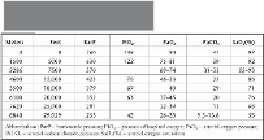Travel Reference
In-Depth Information
6500 to 11,500 Feet (2000 to 3500 M)
In the United States hundreds of thousands of tourists—skiers, climbers, and oth-
ers—ascend to these altitudes, at which most altitude illnesses occur. Although newcomers
ascending above 5000 feet (1500 m) may notice a decrease in athletic performance, not
many have any other symptoms. Some unusually susceptible individuals may have mild
mountain sickness as low as 6500 feet (2000 m), but serious altitude illnesses—pulmonary
or cerebral edema—are rare at that altitude. The incidence of mountain sicknesses in new
arrivals increases from 25 percent to 40 percent as altitude increases from 8000 to 11,500
feet (2400 to 3500 m).
11,500 to 18,000 Feet (3500 to 5500 M)
Several hundred mountains in North America reach these altitudes and are visited by
hundreds of climbers, many of whom get sick. Most highaltitude base camps in the Andes,
Himalaya, and other Asian ranges are above 14,000 feet (4200 m), but the experienced
climbers who attempt these peaks usually know how to avoid mountain sickness. This is
not true of trekkers, and a great many fall ill. A few die. Rapid ascent to such altitudes
without prior acclimatization is dangerous and can cause all the different types of altitude
illness. (In this text these altitudes generally are referred to as “high” altitude).
18,000 to 29,000 Feet (5500 to 8800 M)
The great mountains of Asia and South America attract experienced mountaineers who
know to avoid illness by careful acclimatization. Those susceptible to mountain sickness
infrequently go too high. These individuals do occasionally succumb to severe altitude-re-
lated illness, but most of their difficulty comes from prolonged stays above 20,000 feet
(6100 m) that cause loss of physical and mental fitness rather than acclimatization prob-
lems. Humans live permanently at altitudes up to 17,500 feet (5400 m), where the pressure
of oxygen in the atmosphere is about 80 mm Hg (
Table 24-2
)
, but above this they do not
thrive. Above 20,000 feet (6100 m) humans deteriorate rapidly over days to weeks.
Table 24-2
Gas Pressures at Various Altitudes (mm Hg)
RESPONSES TO INCREASING ALTITUDE

Search WWH ::

Custom Search